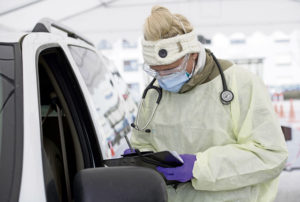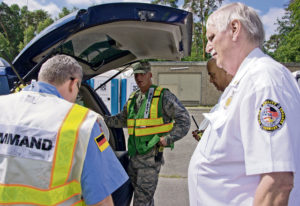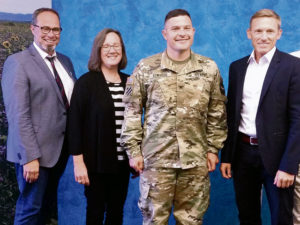With more than 50,000 Americans and nearly 200,000 of its own citizens, the Kaiserslautern area has long been recognized as being the largest U.S. military community overseas. It’s no surprise that over the decades, many residents of both nationalities have come to speak each other’s language and build lasting partnerships — the kind of well-established communication and friendship that has been integral in the joint effort to mitigate the spread of coronavirus in this area.
In fact, shortly after U.S. Army Garrison Rheinland-Pfalz Commander Col. Jason Edwards arrived in July 2018 he met with the Kaiserslautern County Commissioner and his emergency response chief to discuss mutual capabilities for a joint response to a crisis situation. One of the initial discussion topics was preventing and responding to the African swine fever virus — a concern coming across European borders at that time.
Since then, Edwards has emphasized regular contact and sharing of crisis response planning ideas with the county and city’s emergency management teams, thereby strengthening interoperability between the U.S. forces and its host nation counterparts.

While none at the time could have foreseen the current global pandemic, that groundwork has been key during the local COVID-19 response effort, with defined relationships, established communications channels and a team identity to work together to keep the number of positive cases to a minimum.
“I am thankful for the good communication between U.S. and German health authorities,” said Deputy County Commissioner Peter Schmidt, the lead for the county’s COVID-19 crisis response team and part of the 2018 meeting between Edwards and County Commissioner Ralf Lessmeister. “Everything is running smoothly for coordination. We appreciate the successful execution of what was actually promised.”
During the most recent touch point, a conference call on April 24 between Edwards, Lessmeister, Schmidt and Brig. Gen. Mark August, the 86th Airlift Wing Commander at nearby Ramstein Air Base, the county’s roll up of positive case numbers had not only stabilized, but decreased over the previous week — mirroring the Kaiserslautern Military Community.
Schmidt reported 203 total positive cases for the city and county, which includes the U.S. numbers being reported to them daily. With the aforementioned combined population exceeding 250,000, the spread of the virus has been statistically low as compared to other areas.
“The U.S. forces are following (country and state of Rheinland-Palatinate) restrictions appropriately,” Lessmeister said, thanking Army and Air Force leadership. “We appreciate the messaging of such information (host nation restrictions) to help conform with (our rules) and help keep our numbers down.”
“We are doing very well in adhering to every host nation requirement for both information sharing and following of restrictions,” concurred Edwards. “We remain overt about synchronizing across the board and staying in line with the guidance our host nation puts forth, as evidenced by our SRO’s General Order Number One restrictions that mirrored German Chancellor (Angela) Merkel’s guidance.”
The Army’s Senior Responsible Officer for the KMC, Maj. Gen. Christopher Mohan, commanding general of 21st Theater Sustainment Command, has released several videos and conducted live streams along with Edwards’ weekly virtual town halls as they have pushed pertinent information on restrictions impacting the U.S. forces community.

From the Air Force side, August also lauded the joint U.S.-German effort in the region: “Thank you to the host nation team for how we’ve tackled this together. Credit the reduction in cases to restrictions placed from both the DOD and our host nation.”
Two of the primary factors in flattening the curve locally have been proper data sharing between U.S. and German health officials and successful preventive efforts in identifying close contacts of confirmed positive cases via trace teams.
“Cooperation has been absolutely fantastic,” said Edwards. “We recently had a joint Army-Air Force-Host Nation trace team discussion and there are no seams or gaps in our accounting, down to all of the individual calls being made to contacts.”
That assessment is echoed by all involved.
“The coordination with our German Public Health Department — the Kaiserslautern Gesundheitsamt — is very good,” said Army Lt. Col. Laura Ricardo, Chief of the Preventive Medicine Division at Landstuhl Regional Medical Center. “We have been corresponding and speaking with our counterparts throughout this pandemic on a weekly basis, sometimes daily when we need clarification on synching our processes. We (Army and Air Force) have been providing them the reports as they have requested to be in compliance with the SOFA (Status of Forces Agreement).
“They receive the information of every positive COVID-19 case,” she continued, “and we provide them information of close contacts who live outside the base to reassure we are maintaining their protocols in protecting their German community.”
Ricardo also said the Army and Air Force trace teams work very closely “as many of our COVID-19 positive cases are integrated, such as joint families and co-workers. We share our reports on a daily basis and basically work as a unified Team Trace.”
The Army and Air Force track every positive patient in the KMC through their entire infection period to their release date as approved by designated medical professionals, explained Air Force Capt. Patricia Baker, public health officer at Ramstein.
“These efforts are crucial and increasingly important in the global effort to combat the COVID-19 pandemic,” Baker said. “Every infection we prevent, in turn, could mitigate a complication or severe case from manifesting. As we have seen, some people acquire the infection and are able to stay at home and recover with no issues. On the other hand; we have seen COVID-19 cause serious complications, especially in communities where caseloads have been high.”

In addition to the aggressive joint service follow-up on cases, Baker said the teams also work hand-in-hand with German health officials in situations where household members are quarantined off post and are tracked and medically managed by the host nation.
“We are in constant communication with the local public health department to ensure that our protocol for quarantine and isolation match their host-nation goals,” she added. “The Robert Koch Institute is the overarching recommendation and regulation authority for disease control and mitigation within Germany so it’s paramount that we have a good flow of communication between the local public health office and our offices all year round; and especially during our COVID pandemic response. Our interactions have been consistently strong and constructive throughout the COVID-19 mitigation efforts (and) our Public Health Emergency Officers from the Army and Air Force have very good working relationships with the doctors and professionals at the Kaiserslautern Public Health Department.”
One of those PHEOs is Dr. Robert Weien, normally the chief of occupational medicine and deputy chief of preventive medicine at LRMC, but currently tasked as the garrison PHEO to assist Edwards and his Emergency Operations Center staff with Team Trace and other functions.
Weien re-emphasized the strong partnership between U.S. forces leadership and German officials, both on the political and health-related fronts, as being vital to overall efforts in the Kaiserslautern area.
“The relationship has been open and productive,” he said. “We have met with our counterparts at their offices downtown, and we are in daily contact to ensure cooperation is thorough and ongoing. A common goal is that no cases get missed and duplication of efforts is minimized. Our communication with our direct counterparts is good, and our joint communities are benefiting from that.”
The chief of Kaiserslautern’s public health department agrees.
“Close communication is essential in order to reach all affected people in overlapping situations,” said Dr. Christiane Steinebrei. “Each new case is a good example that the procedures developed with regard to (COVID-19) require specific coordination, which is achieved through intensive and constructive inquiries on both sides.”
She added that while “infectious diseases know no borders, the proposed response of the RKI and the U.S. Centers for Disease Control and Prevention mirror each other.”
Even with a unified front against a common adversary, it hasn’t been easy.
“There have definitely been times of too much stress and too little sleep, trying to maintain the health and safety of our community members,” said Baker. “I am incredibly grateful for the excellent cooperation and teamwork we have established between our local Air Force, Army and host-nation counterparts.”
That teamwork is not something Edwards takes for granted, despite longstanding history, current mutual efforts and shared hardships.
On April 27, he and Mohan sent a co-signed letter to all of the mayors and host nation emergency services chiefs whose communities are adjacent to the 29 sites and installations in the garrison’s Germany footprint — which stretches more than 100 miles from Baumholder over to Mannheim and down to Germersheim.
The letter stated in part: “As we all deal with this situation, we would like to take the opportunity to thank you for your friendship and support. It is very reassuring to have a trusted and reliable partner like you and we value the strong relationship we’ve built over decades that will get us through this together… we want to ensure we stay in contact and let you know that we are thinking of you as we all fight this virus together. We look forward to seeing you again soon. Until then, stay safe and stay healthy.”


